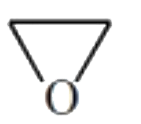The reaction of RCN with R'MgX, followed by hydrolysis gives
an aldehyde
a ketone
2∘ alcohol
3∘ alcohol
The correct Answer is:B
To solve the problem, we will analyze the reaction of RCN (a nitrile) with R'MgX (a Grignard reagent) followed by hydrolysis step by step.
Step 1: Identify the Reactants
The reactants are:
- RCN, which is a nitrile (RC≡N).
- R'MgX, which is a Grignard reagent.
Step 2: Understand the Mechanism of Reaction
In the reaction, the Grignard reagent (R'MgX) will react with the nitrile (RCN). The carbon atom in the nitrile is electrophilic, while the alkyl group (R') from the Grignard reagent is nucleophilic.
Step 3: Nucleophilic Attack
The nucleophilic alkyl group (R') from R'MgX attacks the electrophilic carbon of the nitrile (RC≡N). This leads to the formation of an intermediate:
- The carbon of the nitrile becomes a double bond with the alkyl group (R') and the nitrogen becomes bonded to the magnesium halide (MgX).
The reaction can be represented as:
RCN+R′MgX→RCR′=N⋯MgX
Step 4: Hydrolysis of the Intermediate
Upon hydrolysis (usually with water or an acid), the intermediate undergoes a reaction where the nitrogen atom is protonated, and the bond between the carbon and nitrogen breaks. This results in the formation of a ketone and a byproduct.
The hydrolysis can be represented as:
RCR′=N⋯MgX+H2O→RC(=O)R′+Mg(OH)X+NH2
Step 5: Identify the Product
The final product after hydrolysis is a ketone (RC(=O)R') along with byproducts (Mg(OH)X and NH2).
Final Answer
The reaction of RCN with R'MgX followed by hydrolysis gives a ketone.
---
The reactants are:
- RCN, which is a nitrile (RC≡N).
- R'MgX, which is a Grignard reagent.
In the reaction, the Grignard reagent (R'MgX) will react with the nitrile (RCN). The carbon atom in the nitrile is electrophilic, while the alkyl group (R') from the Grignard reagent is nucleophilic.
The nucleophilic alkyl group (R') from R'MgX attacks the electrophilic carbon of the nitrile (RC≡N). This leads to the formation of an intermediate:
- The carbon of the nitrile becomes a double bond with the alkyl group (R') and the nitrogen becomes bonded to the magnesium halide (MgX).
RCN+R′MgX→RCR′=N⋯MgX
Upon hydrolysis (usually with water or an acid), the intermediate undergoes a reaction where the nitrogen atom is protonated, and the bond between the carbon and nitrogen breaks. This results in the formation of a ketone and a byproduct.
RCR′=N⋯MgX+H2O→RC(=O)R′+Mg(OH)X+NH2
The final product after hydrolysis is a ketone (RC(=O)R') along with byproducts (Mg(OH)X and NH2).
The reaction of RCN with R'MgX followed by hydrolysis gives a ketone.
Similar Questions
Knowledge Check
Cumene on reaction with oxygen followed by hydrolysis gives
ACH3OH and C6H5COCH3BC6H5OHand(CH3)2OCC6H5OCH3 and CH3OHDC6H5OH and CH3COCH3
Maltose on hydrolysis gives
View SolutionMaltose on hydrolysis gives
View SolutionBenzonitrile on reaction with C2H5MgBr, followed by hydrolysis, gives.
View SolutionAcetoisonitrile on reaction with C2H5MgBr followed by hydrolysis, gives compound (A), which one further hydrolysis gives (B) and (C).
(B) and (C) are :
View SolutionEthylmercaptan is prepared by the reaction of the following, followed by hydrolysis :
View SolutionPropylsulphinic acid is prepared by the reaction of the following, followed by hydrolysis :
View SolutionThe reaction of benzaldehyde with HCN followed by hydrolysis gives ………………
View Solution

 The reaction of Oxirane with RMgX followed by hydrolysis will lead to product ?
The reaction of Oxirane with RMgX followed by hydrolysis will lead to product ?